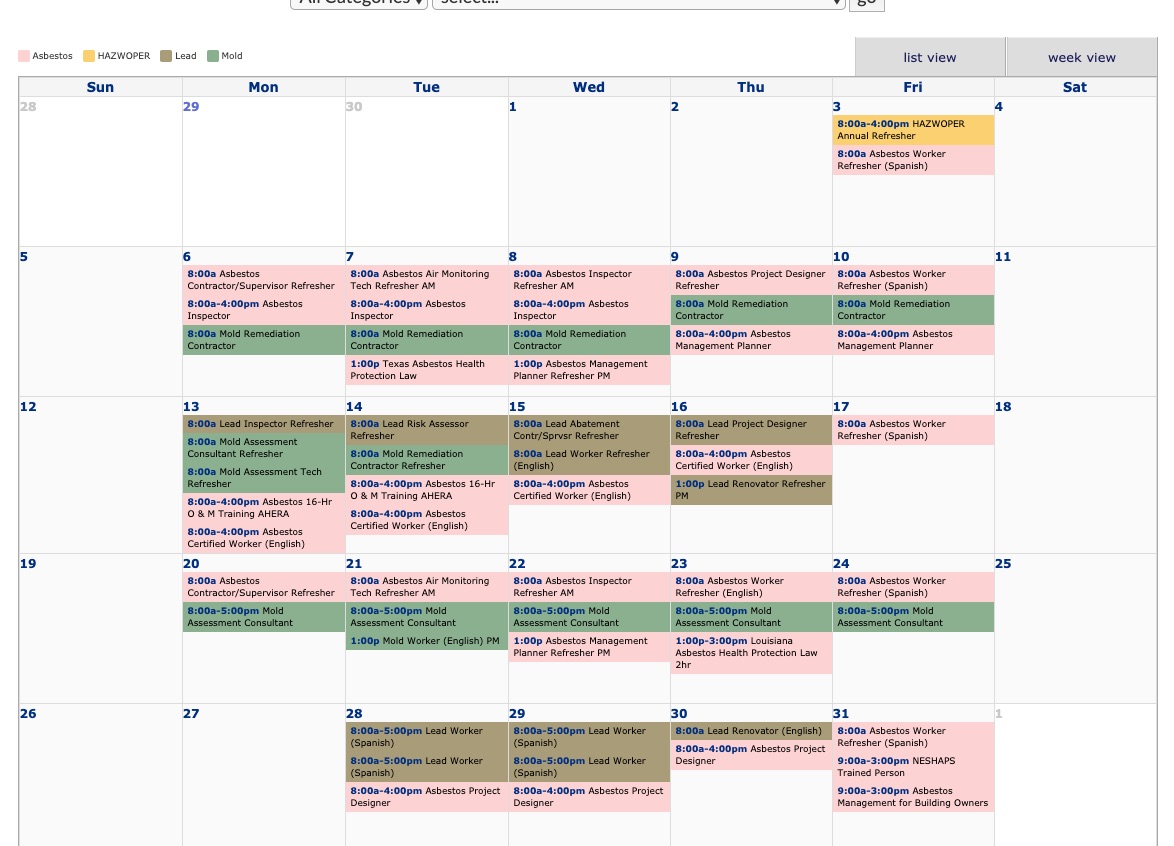Mold
All GEBCO mold courses are listed here along with their purpose. Click on the course name to view more specific information about each course.
Mold Remediation Worker * -- To perform mold remediation work
Mold Assessment Technician * -- To perform mold inspection work
Mold Assessment Consultant * -- To perform mold inspection work, evaluate and develop remediation plans
Mold Remediation Contractor * -- To prepare remediation work plan, perform remediation and supervise workers
(* Refresher course required)
Mold Remediation Worker * -- To perform mold remediation work
Mold Assessment Technician * -- To perform mold inspection work
Mold Assessment Consultant * -- To perform mold inspection work, evaluate and develop remediation plans
Mold Remediation Contractor * -- To prepare remediation work plan, perform remediation and supervise workers
(* Refresher course required)
Mold Courses
Mold Remediation Worker (English and Spanish) - 4 hours(1) sources of indoor mold and conditions necessary for indoor mold growth;
(2) potential health effects and symptoms from mold exposure, in accordance with a training protocol developed in consultation with state professional associations, including at least one representing physicians;
(3) workplace hazards and safety, personal protective equipment including respirators, personal hygiene, personal decontamination, confined spaces, and water, structural, and electrical hazards;
(4) technical and legal considerations for mold remediation, including applicable regulatory requirements, the role of the worker, and the roles of other professionals;
(5) an overview of how mold remediation projects are conducted, including containment and air filtration; and
(6) work practices for removing, cleaning, and treating mold.
Mold Assessment Technician - 24 hours
(1) sources of, conditions necessary for, and prevention of indoor mold growth;
(2) potential health effects, in accordance with a training protocol developed in consultation with state professional associations, including at least one representing physicians;
(3) workplace hazards and safety, including personal protective equipment, and respirators;
(4) technical and legal considerations for mold assessment, including applicable regulatory requirements, the role of the mold assessment technician, and the roles of other professionals (including an assessment consultant);
(5) performance of visual inspections where mold might be present and determining sources of moisture problems, including exterior spaces (including crawlspaces and attics), interior components (including windows, plumbing, walls, and ceilings) and heating, ventilation, and air-conditioning (HVAC) systems (including return air and supply ducts);
(6) utilization of physical measurement equipment and tools, including moisture meters, humidity meters, particle counters, data-logging equipment, and visual and robotic inspection equipment;
(7) biological sampling strategies and methodologies, including sampling locations and techniques, and minimizing cross-contamination;
(8) sampling methodologies, including bulk, surface (including tape, swab, and vacuum sampling), and air sampling (including the differences between culturable and particulate sampling, sampling times, calibrating pumps, selecting media for culturable samples, and sampling for fungal volatile organic compounds);
(9) state-of-the-art work practices and new technologies;
(10) proper documentation for reports, including field notes, measurement data, photographs, structural diagrams, and chain-of-custody forms;
(11) an overview of mold remediation projects and requirements, including containment and air filtration; and
(12) clearance testing and procedures, including review of mold remediation protocols, work plans, visual inspections, and sampling strategies.
Mold Assessment Consultant - 40 hours
(1) all topics listed above for Mold Assessment Technician, including appropriate hands-on activities;
(2) requirements concerning workplace safety, including components of and development of respiratory protection plans and programs, workplace safety plans, and medical surveillance programs;
(3) technical and legal considerations for mold assessment, including applicable regulatory requirements, the role of the assessment consultant, the roles of other professionals, record keeping and notification requirements, insurance, and legal liabilities;
(4) an overview of building construction, building sciences, moisture control, and water intrusion events;
(5) prevention of indoor air quality problems, including avoiding design and construction defects and improving maintenance and housekeeping;
(6) basics of HVAC systems and their relationship to indoor air quality (including psychometrics, filtration, ventilation and humidity control), HVAC inspection and assessment, and remediation of HVAC systems;
(7) survey protocols for effective assessment, covering the areas described under subsection (b)(5)-(8) of this section;
(8) interpretation of data and sampling results;
(9) interviewing building occupants, minimum requirements for questionnaires, and interpreting results;
(10) writing mold management plans and mold remediation protocols, including format and contents (including structural components, HVAC systems, and building contents), defining affected areas (including floor plans), identifying and repairing moisture sources and their causes, developing a scope of work analysis, specifying containment and air filtration strategies, determining post-remediation assessment criteria, and clearance criteria;
(11) post-remediation clearance testing and procedures, including review of mold remediation plans, visual inspections, sampling strategies, and quality assurance; and
(12) case studies.
Mold Remediation Contractor - 40 hours
(1) sources of indoor mold and conditions necessary for indoor mold growth;
(2) potential health effects, in accordance with a training protocol developed in consultation with state professional associations, including at least one representing physicians;
(3) requirements concerning workplace hazards and safety, personal protective equipment including respirators, personal hygiene, personal decontamination, confined spaces, and water, structural, and electrical hazards;
(4) requirements concerning worker protection, including components of and development of respiratory protection plans and programs, workplace safety plans, and medical surveillance programs;
(5) technical and legal considerations for mold remediation, including applicable regulatory requirements, the role of the mold remediation contractor, the role of the mold remediation worker, the roles of other professionals, insurance, legal liabilities, and record keeping and notification requirements;
(6) building sciences, moisture control, and water intrusion events;
(7) an overview of how mold remediation projects are conducted and requirements thereof, including containment, and air filtration;
(8) work practices for removing, cleaning, and treating mold, including state-of-the-art work practices and new technologies;
(9) development of a mold remediation work plan from a protocol, including writing the work plan, detailing remediation techniques for the building structure, HVAC system, and contents, delineating affected areas from floor plans, developing appropriate containment designs, determining HEPA air filtration requirements, and determining dehumidification requirements;
(10) clearance testing and procedures, including a review of typical clearance criteria, visual inspection of the work area prior to clearance, and achieving clearance;
(11) contract specifications, including estimating job costs from a protocol and determining insurance and liability issues; and
(12) protecting the public and building occupants from mold exposures.

